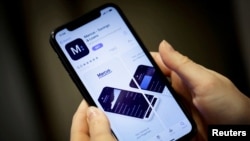Even before the pandemic, Cambodia had established itself as one of the most loan-saturated markets in the world, thanks largely to the proliferation of microfinance institutions and weak oversight of the sector.
The combination of COVID-19 and the rise of digital lending are now poised to accelerate indebtedness even further, as individuals trying to recover from the pandemic have easier-than-ever access to no- or low-collateral loans. Advocates for the “fintech” platforms, now widely advertised on Facebook, say they allow for cheaper interest rates and more inclusive lending, by reducing human overhead and reaching anyone with a smartphone. But debt experts and nonprofits cast doubt on the model, and say more debt is the last thing Cambodia’s rural and urban poor need.
“Cambodia has one of the most over-indebted microloan sectors in the world, with average loan sizes several times larger than annual incomes,” said Naly Pilorge, director of prominent rights group Licadho, which monitors the consumer finance sector.
“People need debt relief now; they don’t need new ways to get more loans,” she added.
As of December 2020, a joint report from nonprofit Licadho and Equitable Cambodia found that Cambodia had 2.8 million loans for 3.6 million households, totaling $11.8 billion, with an average “microloan” size of $4,280, higher than the annual income of 95% of Cambodian households.
Many Cambodians are trapped in a debt cycle, taking out new loans to pay off older ones, rather than using the money to invest in assets or sustainable business models. And when formal financial institutions start to turn them down, they are often forced to turn to informal private lenders or local loan sharks to stay afloat.
New online outfits like Boost Capital, Luy Luen (quick money) and Spean Luy (bridge money), argue they provide a more affordable opportunity to existing lenders, and believe there’s still plenty of untapped demand in the market.
These fintech platforms are partnering with MFIs or using their own funds to offer, in some cases, almost instant loans, without the hassle of visiting the bank. And it’s not just new fintech players, established banks such as ACLEDA are also moving to expand their offerings to compete in the digital space.
Emergency relief
For some, these digital loans have been a lifeline. In May, the scene from Loem Erica’s grocery store looked grim. Police were stationed throughout the industrial district of Phnom Penh’s Stung Meanchey, enforcing the controversial “red zone” lockdown amid the city’s first COVID-19 wave.
For thousands in the area, the loss of an already precious daily wage made life unmanageable. With many unable to afford food, businesses like Erica’s were put in an impossible position: let impoverished families run up their tabs, or watch their neighbors go hungry.
So Erica decided to let the tabs swell, but the lack of income made it hard to buy new stock – which is why a Facebook ad targeting female entrepreneurs in need of loans caught her eye.
She quickly began chatting with the company, Boost Capital, which allowed her to apply entirely over her phone. And within four days, she had secured a $3,500 uncollateralized loan from microlender MIA Plc, which kept her afloat during the worst of the pandemic.
“During Covid-19, we needed money urgently,” Erica said. And MIA Plc, aided by Boost’s platform, met the moment. “Everyone just works from home, interviews and everything, it’s very fast,” she said of the lending process.
Spean Luy is looking to spread the word online too. Its website offers three simple steps for would-be borrowers. “Apply for instant cash on app – just answer simple questions, and upload your ID,” the video says, with upbeat music playing on a soft orange background. “Get cash up to $1,000 in seconds.”
The service, owned by Singaporean company Digicro, boasts lightning fast lending decisions backed by machine learning. Since its founding in 2017, Digicro says it has distributed $12 million with one million app downloads.
Other tech-savvy lenders bounce automated Facebook messages to users, offering budgeting advice juxtaposed with information on loan products. The common theme in the marketing is speed and convenience, with each promising to send money in mere days, hours, or minutes.
While machine learning has allowed financial firms to process data much faster than in the past, there are still questions about the quality of the decisions being made, said Tola Chea, senior manager at Mekong Strategic Partners, a financial consultancy in Cambodia.
“We're also seeing the decisioning process being addressed digitally through automated credit scoring models; again to improve turnaround times, but also, through the use of machine learning analyzing more data-points, it provides a stronger predictive power for credit scoring,” he said.
“However, the obvious challenge here, or competitive advantage, can be the institution's access to sufficient and reliable data,” Tola Chea said.
Boost Capital leaves the final decision to the financial institution making the loan. Co-founders Gordon Peters and Lucinda Revell, who both have backgrounds in the business and development sectors in Cambodia, say they saw an opportunity in 2018 to plug a gap in the lending market through an easy access point: smartphones.
Boost found that by eliminating the costs of branches and in-person staff, their loans are 20% cheaper than traditional MFIs, and estimates that their process also saves applicants five to seven days.
“There's no reason loans need to be so expensive for people. They should be cheaper if you integrate the right technology, if you bring down operating costs on the bank's part, you don’t have huge branch networks that are adding huge costs, if you're using digital effectively,” Revell said.
“The problem is, most microfinance is still delivered through in-person interaction at a bank branch. It's not great during a pandemic, especially for female entrepreneurs.”
Of the company’s already $1.6 million in dispersed loans, about 80% have been uncollateralized, and stories such as Erica’s are noteworthy in their flexibility for female entrepreneurs.
Other examples in the country show that a start in the interest of financial inclusion doesn’t always prevent over-indebtedness from occurring, as with major bank ACLEDA, which began as an international development project in the 1990s between the United Nations Development Programme (UNDP) and the International Labour Organization.
Today, it accounts for 40% of Cambodia’s loan market, and offers uncollateralized loans up to $2,500 at a rate of 5.5% to 15% per year. ACLEDA’s spokesperson Seong Phorn says that in-person meetings are vital to ensure the client is educated on the magnitude of the loan.
“For the other type of loan, our bank staff needs to meet face to face and discuss and they can exchange the documents at that time and explain about the loan,” he said. “And any kind of financial literacy and education to [make sure] the loan is the proper amount and properly used.”
Among the early leaders in the digital lending space is Luy Luen, or “quick money,” which was launched by Singapore-based Delight Tech in 2020. Unlike Boost, which is a technology application service and not a lender itself, Luy Luen uses clients’ cellphones as collateral for loans between $50 and $1,000.
While not regulated by the National Bank of Cambodia, co-founder Vila Lay says the company operates under Ministry of Economy and Finance guidelines. “Currently, we can say we use our own funds to provide loans to the customer because we’re a start-up and we cannot connect with any bank because we need many regulations and compliance,” he said.
“During this Covid pandemic and also looking at underbanked people and unbanked people, it’s difficult to get loans, they get more access to loans and finance also [through Luy Luen]. Most of them don't have credit, don’t have history,” he added.
The National Bank of Cambodia and the Credit Bureau of Cambodia declined to comment on the rise of digital lending platforms or oversight of the sector.
Weighing the risks
Despite the differences between digital lenders, there is a similar sense of altruism — of meeting the needs of unbanked populations and providing some financial education along the way.
Licadho, a nonprofit that researches Cambodia’s debt crisis, disagrees with the notion that new lending channels are needed in the country, and casts predatory lending as a human rights issue.
“We believe that MFIs and their funders cannot ‘balance’ human rights with things like inclusivity or accessibility – you either respect human rights, or you violate them,” said Pilorge, the group’s director. “Right now, Cambodia’s microlenders are violating them, and we continue to call for them to stop these harmful practices.”
Their past recommendations have called for the return of land titles, independent investigations into abuses, debt relief for borrowers, enforcement of existing laws against coerced land sales and lowering effective interest rates for distressed borrowers.
Khun Tharo, director of Cambodian labor rights organization Central, isn’t ready to dismiss the potential of digital lending outright. But he said that financial products should be calibrated for the specific populations they are meant to uplift, with third-party auditing, monitoring and evaluation of repayment and default rates.
For groups like urban, educated residents, fast and affordable loans could be beneficial, he said. “It’s all about trying to reduce their cost, particularly on labor cost and also increase productivity and inefficiency as well,” Khun Tharo said about going digital. “It depends on if they’re really targeting the urban development areas.”
One Phnom Penh woman, who asked for anonymity to candidly discuss her finances, applied for a loan over Facebook along with her husband for their joint contracting business. A friend recommended the service, saying the interest rate was much cheaper than other microfinance institutions.
For their $5,000 uncollateralized loan, they told a reporter that they were offered a rate of less than one percent, yet the rate actually offered by the loan provider was 1.4%. The misunderstanding is indicative that communication problems or a general lack of understanding about the terms of the loan exist at times between borrowers and lenders. The digital lender required proof of the husband’s job at a cement company, information about his wife’s income selling lunches and rice at the market, a photo ID and a copy of their family book.
The couple is confident they can earn enough to pay back their newest loan, but also have several other loans they’d taken out in the past, including a $10,000 loan through a provincial bank and another $2,000 loan they received through an alternate online service, although they couldn’t remember the name of the company.
As for whether the loan services are helping those historically excluded from finance, time will tell as more of these services become mainstream in the lending space. The couple still feels uncertain about navigating the fintech landscape – but if incentives like lower interest rates and larger uncollateralized loans grow more enticing, the industry is unlikely to slow down.
"I see lots of people are using [smartphones]. But for me, I am not even good at using an ATM, I don't know how to use it because I am worried that I would lose money,” said the wife. “I feel that I don't trust it. I just keep my money with me in the locker instead."
But she said they were confident in the new debt and that the loan she secured wouldn’t be a problem. "I don't have any concerns,” she said. “I earn the income easily."













